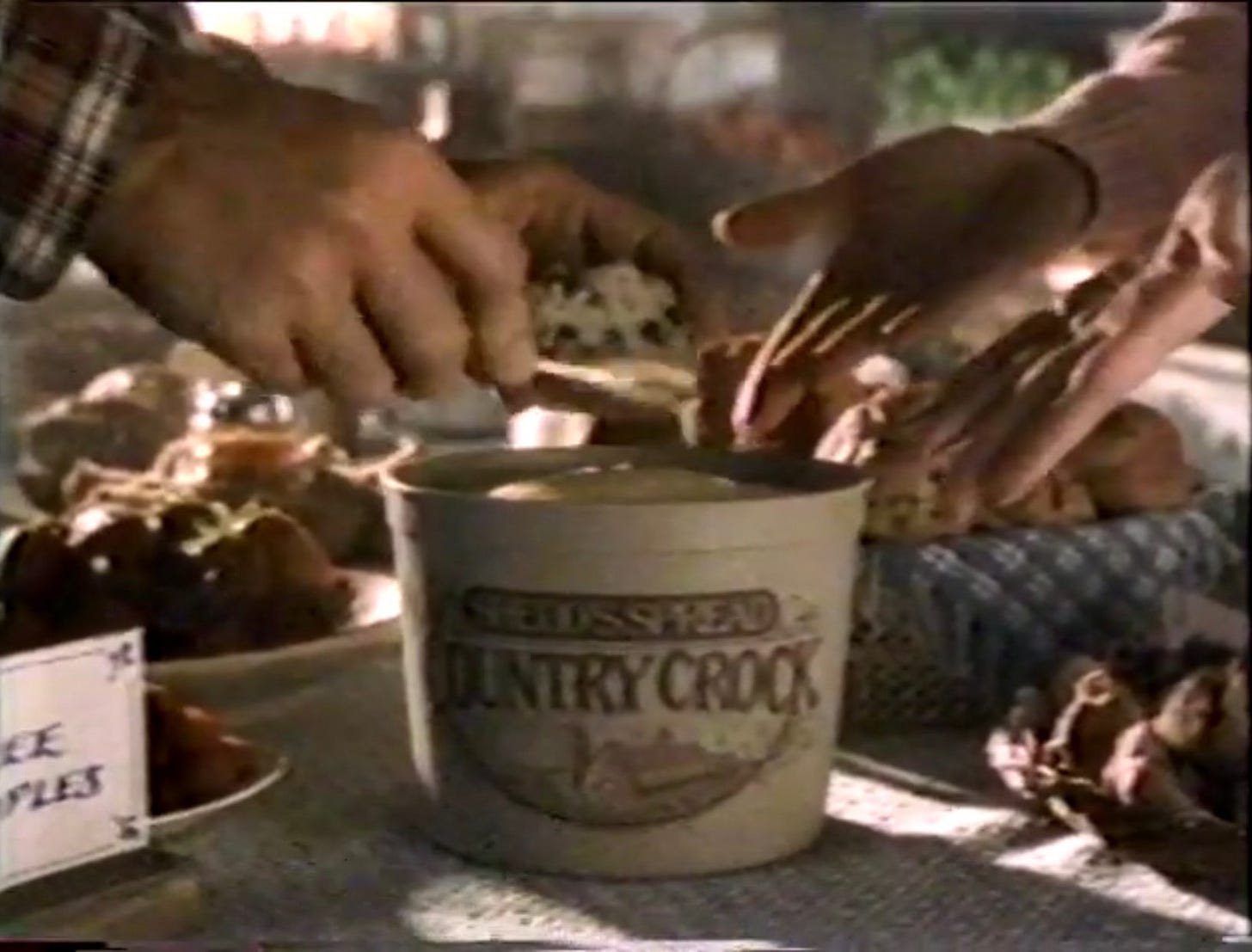The Nostalgic Romance of Country Crock
A tub of trans fat, two pairs of hands, and long-term love.
As a child of the eighties and nineties, my concept of love and sex was shaped—for better and worse—by John Hughes. A part of me is still waiting for Jake Ryan to pick me up from the wedding in his red Porsche. It’s not an exaggeration to say that my concept of married life was shaped in part by butter. Well, not butter exactly, or I can’t believe it’s not butter, but it’s even more down-home cousin, Shedd’s Spread Country Crock.
Full disclosure: I've never actually tasted Country Crock because my mother thankfully only used Land O’ Lakes. Margarine was verboten in our house. Thanks, mom! Alas, my daughter is now about to turn sixteen, seed oils are now a hotly debated mainstream topic, and my own 20th wedding anniversary is fast approaching.
The Country Crock commercials featuring a married couple penetrated my psyche. In my memory, the wife feeds her husband a freshly baked and Crocked muffin, but in reality we only ever saw their hands, their butter knives gesticulating over the brown plastic tub of trans fat. My mind completely made up what they looked like until the blessed internet reminded me that we never actually saw their faces or other body parts. In my mind, he wore pleated Dockers and had brown hair, she was blonde and pretty.
Their relationship—not to mention their seemingly unlimited ingestion of baked goods and starches—suggested a wholesome happiness I craved. The husband was always joking, making the wife laugh. She was always slightly chastising but laughing despite herself. The husband was a bit naughty, his butter knife a little wild. Sometimes the wife touched his hand, though rarely. The hand models buttered their biscuits and muffins in a certain unrealistic wavy pattern I would always try to emulate on my Thomas’ English muffin. But real butter always melted too quickly. It was the spreadability that mattered, the way Country Crock sat undeterred for a moment. I wanted that. I was in fifth grade when the commercials began, but by 1990 I ate my English muffin dry with grape jelly. The butter sat ignored in the butter dish. I was already afraid of fat.
The couple—I will call them the Crockers—flirted with wholesome banter as they buttered each other’s muffin. The innuendo was lost on me at age eleven, but there was a trickle of erotic energy, just enough, that permeated the commercials. One could imagine what would happen later behind closed doors if they allowed themselves an extra glass of Ernest & Julio White Zin. The wife’s voice had a silky quality to it, a slightly throaty purr. The husband has a practicality to his voice—he definitely drove a wood paneled Dodge minivan—but one imagines his quirky sense of humor could turn raunchy once the lights were off. Besides, the Crockers must have been in decent shape; they took care of their bodies by eschewing butter for its low fat doppelganger, Country Crock, which contained even less fat and calories than margarine!
We watched as the wife announced her pregnancy to her husband, with the introduction of “trial size” Country Crock. We celebrated Christmas with them. His boss came for dinner. There was a bake sale. The Country Crock spread came in tubs, then sticks, then squeeze bottles, trial-sized tubs and giant tubs. It came with corn oil (ew). Then they added yogurt for a homey touch. They would add honey to their low-fat concoction to make it even worse. It was full of trans fats, which they removed in 2012 when science made it clear that trans fats caused disease. Now Country Crock is a mix of soybean, palm and palm kernel oils, which are also linked to a number of health issues.
I can’t help but imagine the Crockers now, in their late seventies, after decades of eating whole-grain muffins with low fat margarine; him obese and diabetic, and her fighting cancer. It’s a shame, after they eagerly heeded Jane Brody’s advice for all those years. I imagine the commercials now would be silent; they have already said all the words, and know each other’s thoughts. The easy choreography of their hand movements are earned from decades together. Their hands might shake slightly as they Crock their long-fermented sourdough; perhaps she has to crock his for him. Perhaps some old resentment creeps in. I hope they’re okay.
One commercial really pounded the word “country”, using it three or four times in only thirty seconds. Country Crock rode on butter’s long and sturdy coattails, its “creamy and buttery taste”. They cashed in on butter’s wholesome reputation, with images of red barns, picket fences and aproned mothers. You could practically see a pioneer woman churning it in the background. (Seed oils are actually made in large factories, using a process of deodorizing, bleaching and sanitizing to make them edible for humans. They are usually rancid by the time they are packaged. Their oxidation is part of what makes them uniquely dangerous to eat. For more, see Tucker Goodrich’s work.)
In contrast to the masculine undertones of red meat, butter has a soft femininity to it. It literally comes from the mammary glands of animals. Butter is ancient, the famed result of herders’ goat milk jostling and separating on long journeys. Yak butter was a staple of the Tibetan diet for millennia as they had little else to eat at their altitude.
Butter became a prized way to add nutrients and flavor to food. Even the Mayflower carted over barrels of butter on the long journey to America. In the early 19th century, butter making became a side-hustle for rural American women, burgeoning into a stable income for farmers before the dairy industry developed. Hunting and farming the fields was the men’s dominion, while butter making belonged to the women. Americans loved butter and by the turn of the 20th century, we were eating almost a stick and a half per person per week. We had almost no heart disease or obesity.
We should get back to that. Butter is a healing nutrient-dense food, full of butyrate which is a short-chain fatty acid that can heal the gut. It contains stearic acid, another fatty acid that stimulates fat burning. (Perhaps it’s why the French can consume all-butter croissants and not gain weight?) Butter is a rich source of important essential vitamins: A, K2, B12, and D. Slathering butter on our vegetables helps us absorb their fat-soluble vitamins. Our grandmothers were right to butter the potatoes, peas, broccoli, and green beans. I now know more about how important healthy fat and cholesterol is for my cell membranes, brain health and especially, as a perimenopausal woman, my hormones.
The 2024 Country Crock doubled-down on the farm appeal, in a colorful plastic tub. I still have no idea what “Shedd’s Spread” is, but it's reminiscent of the confusion surrounding Ruth’s Chris Steak House. (Who is Ruth, goddamn it, and why does she have a Chris?) Nevertheless, Shedd’s Spread boasts of “farm grown ingredients”. Yes, soybeans are grown on farms. It seems that too much of our farmland is used for growing soy, wheat and corn. These mono-crops are highly subsidized and, unless regeneratively managed, deplete healthy soil. To their credit, they have started a Cover Crop project to help heal the soil and help Kansan farmers. The Country Crock container says “Churned in Kansas” but I somehow doubt Dorothy herself is doing the churning. It’s more likely that vats of bleached and deodorized soybean oil never meant for the human food supply are mixed in large vats with natural flavors and whey.
They now also sell a dairy-free “plant butter” made with olive or avocado oil. The majority of the ingredients are still palm, soybean and canola (rapeseed) oils. I don’t know who needs to hear this, but “plant-based” does not equal healthier. It’s worth noting that Country Crock no longer advertises being lower in fat or cholesterol. In 2015, the Nutritional Guidelines quietly removed the limit on dietary cholesterol. There was never any good evidence for limiting cholesterol in the human diet, which kind of undermines the entire necessity of Country Crock. (There is still an absurd limit on saturated fat, but no good evidence points to any harm.) Notably, since we have been limiting saturated fat and replacing it with polyunsaturated fats, our nation’s health has only gotten worse.
If the Shedd’s Spread couple returns for nostalgic Gen Xers, I can only imagine the marketing gurus insisting that the hands belong to a mixed-race couple considering ethical non monogamy to really spice up their organic gluten-free spelt pancakes. Maybe a third hand of indeterminate gender would appear in the background with a pumpkin-spice flavor. But given the mesmerizing fascination with influencer Hannah Neeleman and the seeming ease with which she makes her own butter from raw cream while raising eight children, butter might be back better than ever.
It doesn’t need a PR team. My husband and I buy ours from an Amish farm, but I also love salted Kerrygold. We keep it on the counter so we can spread it on everything easily. Rarely do our hands argue over who gets to butter their banana bread first because my husband prefers a 1-1 bread to butter ratio and I have learned to back away until he’s finished. We have occasionally clashed squares of dark chocolate while running them thru the softened butter for our nighttime snack as we review the day, but this has become a subtle kind of foreplay. Like Princess Buttercup, when my husband butters my steak without asking, I know he’s really saying I love you.
Perhaps we have become the Country Crock couple, just a lot healthier.
I’ll take it.
Jake Ryan can wait.




